Tijara & Tijori

Tijara is just under 100km from Delhi on way to Alwar but it is like 2,000 years away in time. Well, a crime novel, Tijara’s Mystery Codes, written by one of the most unusual storytellers, Hemma Myers Sood, has traced it imaginatively to 5,000 years ago, when the Pandavas no less, stayed here in Matsya kingdom in disguise in the 13th year of their agyaat (incognito) vanavas (exile). The king of adjacent Trigarta hated them and wanted them caught and killed. I’m not telling you the story here. Buy a copy! After a long time, I read a racy crime novel, on par with many established greats like Agatha aunty and uncle Hercules!
Tijara is the new place to go-to on weekends, from Delhi. Each room is lovingly decorated with and by an artist, in whose honour it is named so there is the Anjali (Ela Menon) Mahal, Laila (Tyabji) Mahal, Kishen (Khanna) Mahal… History has stood still here and the place has a calming timelessness about it. It is a soothing getaway from Delhi and high class heritage non-hotel of the Neemrana Group. The place is ultimate India can showcase, where elegance meets education; aesthetics meets arts and arts meets commerce. Aman Nath, the chairman of the Neemrana Group (but actually a magician at heart, the renaissance man of India), has created another gem within five or few years of restoring and renovating it. No wonder the Neemrana Group recently won a prestigious tourism award from the Indian Tourism ministry under the best heritage hotel category.
For three decades, the Neemrana Group has kept the legacy of Indian music and dance alive in its flagship hotel. This year, it added a new festival of icons of Indian dance by platforming two stars/ icons of the Bharatanatyam form, Leela Samson and Malavika Sarukkai.
Leela Samson brought Nadi. River. An ode to water and just like Tansen brought rains to a parched land by singing Raag Malhar, Leela brought rains to a dry, parched, dusty landscape of Tijara! It rained non-stop for three days, making it surreal, even if the staff of Tijara rose up the occasion and guests were not inconvenienced one bit. Team Tijara headed by GM Ganga Thapa, Manager Shourvir and tech genius Mukund made for a memorable stay, which the CEO Sonavi Kaicker efficiently supervised. The guest list included the who’s who of the literary, art and media world. I’m not naming names, in case bit like the Pandavas, they were visiting in an agyaat way too!
Nadi is a very special work and Leela Samson gave it a pan-Indian palette by using songs and poetry from different regions of India. The musicians were Keerthana Vaidyanathan, Anantanarayanan, G Srikanth and Sharmishtha Chatterjee. Music producer Sri Sai Shravanam linked all, seamlessly.
An ensemble work in which each dancer (Aryamba Sriram, Aishwarya, Ashwini Viswanathan, Nidheesh, Harikrishna, Season and Bhavajan Kumar) performed with sense of involvement and enthusiasm. Leela Samson danced with an understated quality that had repose and rarely seen peace in recent Bharatanatyam productions. She has reached that point in art where everything is centered and calm. Her choreography was uncluttered and soothing. Even on a small stage – and thunderous rain pouring all around – she made a strong artistic statement. The music was freshly composed, redesigned from old compositions and reset by veteran Rajkumar Bharathi. It was recorded, mixed and mastered by Sai Shravanam. This is one production that represents India in a pan-Indian way with major languages and music traditions and it is worth travelling to any and every major festival abroad. And within India, of course because it connects Ganga with Vaghai and Hindi with Bangla.
Talking about this work next day with audiences that had come from far and near, despite torturous truck traffic on potholed roads, made worse by non-stop rains for 72 hours, Leela Samson focussed on the process of a production. All that goes into music making, ensemble work, sustaining and travelling with a group. Leela Samson shows seriousness of purposeful art with grounded aesthetics and that essence of atthai – Rukmini Devi, her mentor – that has escaped many others who have learnt at Kalakshetra.
Malavika Sarukkai next day proved one adage I’ve often pondered upon: stage presence. Either one has it or one doesn’t. It can’t be bought or learnt or taught. It is a gift of the Gods. Off-stage one may look ordinary, even passable, like Bala or Zohra. But on stage they are transformed. In my viewing dance for 50+years now, I have seen only a handful possess this quality from among thousands: Ram Gopal, Uday Shankar, Kamala Laxman, Indrani, Yamini K, Sonal Mansingh, Sitara D, Birju M, Kelu Babu Valli and Malavika. The minute she stepped on stage, we forgot the rained-in Tijara Talkies auditorium. She was (like I said in my introduction): a temple frieze or sculpture come to life. Each hasta is perfectly etched, each stance dances. What tautness of lines and delivery. Each position and portion is well etched. Of course, a cursory non-dance audience may not realise what daily grind, practice, hard work goes for decades to reach this state where it all looks so effortless. Malavika Sarukkai seems possessed once on stage. The audiences ate out of her hands and later with her, as the host Aman Nath had hosted dinner for all where anyone could meet the artiste of the evening and interact. One came richer from this Tijara feast.
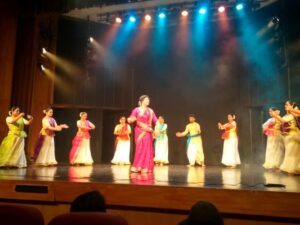
Tijori of Kathak is what senior disciple of Kathak Neelima Adyhe, ace disciple of academician-dancer late guru Rohini Bhate, brought to Delhi in a three-day focus, hosted by Habitat, Raza Foundation and others. She came with her senior students and of other acolytes of Rohini tai like Roshan Datte, Abha and others. Each one gave a good account of their art. Pune dancers are sincere and serious. Actually today, in real terms, Pune is also a garh, epicentre of Kathak, not Delhi alone. There’s quality music, dancers, gurus and legacies.
Terence Lewis and Ashok Vajpayee
The first evening was a mixture of old and new with Ganesha Vandana setting the tone to a copper-toned Terence Lewis performing Kalash with Marukh Dumasia. Unusually powerful piece, which left one realising that all modern dance is not senseless body contortions and gyration! It had metaphors, angst, starkness, rawness and softness, tenderness and suppleness all rolled in one compact presentation. Terence is a master. Period. Need more be said?
I recall seeing him 22 years ago, when he was an upcoming talent in 2000 when NCPA hosted with SNA, a focus on choreography, in aamchi Mumbai. He had come to see all and distribute his literature – the learner in him absorbed much, including begetting a scholarship to Vienna because in his words “my spunk” (and substance) was noticed by Susan Linke, no less and rest is history. Today, he is a star and a humane judge on popular TV dance competitions.
Vaibhav Arekar is among the few male dancers who dances like a man. No mannerisms, no affectations just plain, neat rendition. Akaash was about the space within and around. The Alarippu start was fetching because most BN dancers nowadays are so busy chasing the chimera that they can’t perform even one part of margam properly. Sushant Jadhav’s lights were just right. Minimalism has its own rewards.
Next evening revived a classic work Tanmatra, based on the panchtatva: Earth, water, air, fire, ether. All nine dancers, including Neelima Adhye, participated and each acquitted well. Prajakta Raj stood out for her tayari and quiet solidity of art. She and Abha need to be seen more on solo format. They have the material and professional foundation. Rest were various shades of student-level proficiency:
Ketaki Wadekar, Venu Riswadkar
Shrungali Paranjpe, Shruti Kulkarni
Isha Kulkarni, Arya Lohokare, Neelima Adhye herself joined in and is at best a reference point of past that was.
The lone sweetly smiling boy Mayur Shitole looked lost! Although a day before, he was given a central place. In dance, men need empowerment now! Some editing will help make this rather repetitive work (in fire and water segments) compact and travel worthy.
I won’t limit this to a dance column alone since I have three other platforms exclusively dedicated to dance writing but I will table one point. Why don’t audiences in Delhi pay their way? In Mumbai, Kolkata or Chennai, even Bangalore people pay to see star artistes. Why this 1960s and 70s socialist model of free cultural shows continues in the Capital of India? Why not put a value, even token amount on dance shows? Even when free, the hall goes half full so where lies the lacuna? I recall in 1970s there’s was the great Entertainment Tax that caused so much paperwork (first get permission then keep tic stubs then give accounts then suffer petty babus!) that most of us decided to offer free seats. That was then. 50 years ago. Wake up Kejriwal’s Delhi and put some value in Indian arts. Bijli, pani, free ok, even bus for women, but please help the arts redeem and have some pride. What by the way is the cultural budget of and for Delhi?
Ashish Mohan Khokar is an artivist too, raising questions and issues that help society. This after 45 books and
5,000 articles in mainstream media in last 40 years of writing, teaching, filming, mentoring makes him the
most original voice in dance documentation field. A historian, backed with proof and academics,
he is hailed as the gold standard of Indian dance heritage writing.


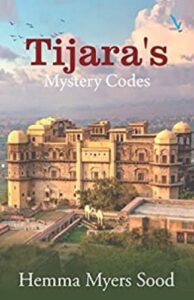
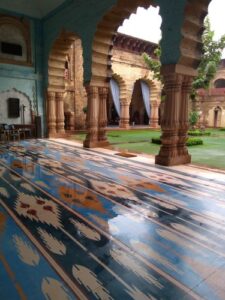

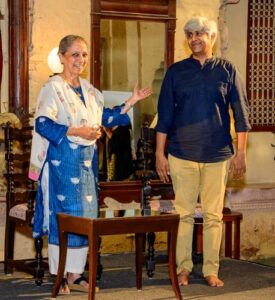
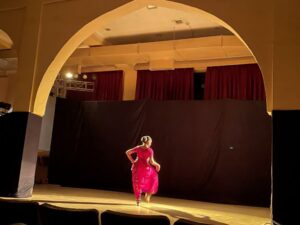
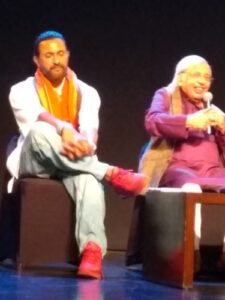

5 Comments
Beautiful! Must have been a treat to watch and witness 🙂
So well said !! You have touched on all the aspects. The book review the reviews of the dancers in such detail. I felt I was there watching it.
Beautifully articulated Ashish ji. 🙏🏻 Thanks for sharing. Such wonderful artists and presentations across.
How to traction necessary funds to uphold our tradition and culture remains as a question unanswered. Thanks to a few quiet patrons.
What a divine piece this is. A veritable work of art that brings together history, culture and reality. The dances were so well presented that I felt I was watching them! Look forward to visiting Tijara and reading Tijara’s mystery codes. Hope I’m lucky enough to watch Nadi one day.
Explicit review Ashish ji of the stalwarts who performed at Tijara.I felt I was there in person while reading your article.I have seen the production Nadi and it was an amazing experience. Very beautifully choreographed. Thank you for sharing.